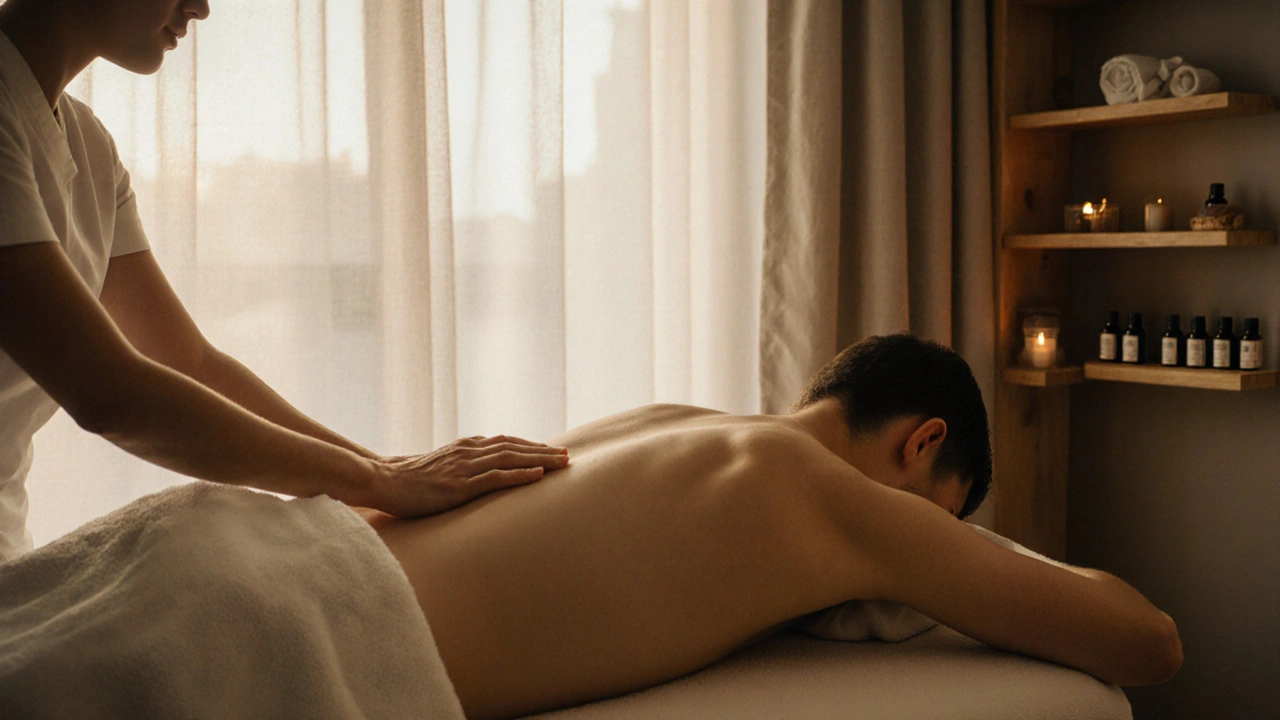Swedish Massage 101: Everything You Need to Know

You’ve probably heard of Swedish massage-maybe you’ve even tried it. But do you really know what happens during one? Or why it’s the most popular type of massage in the world? If you’re wondering whether it’s right for you, or just curious how something so simple can feel so amazing, you’re in the right place.
What Is Swedish Massage?
Swedish massage isn’t fancy. It doesn’t use hot stones, essential oils, or loud music. It’s not meant to fix deep muscle knots or treat injuries. Instead, it’s the gentle, rhythmic hug your body didn’t know it needed. Developed in the 18th century by a Swedish physiologist named Per Henrik Ling, it’s built on five core techniques: effleurage (long gliding strokes), petrissage (kneading), friction (deep circular movements), tapotement (rhythmic tapping), and vibration (shaking or trembling motions).
Think of it like this: if your muscles were a tangled ball of yarn, Swedish massage is the slow, patient hand that gently untwists each loop-not by yanking, but by smoothing. It’s designed to relax, not to punish. That’s why it’s perfect for first-timers, people with stress-heavy lives, or anyone who just wants to feel human again.
Why Do People Love It?
Let’s be real-most of us are running on empty. Work, screens, traffic, responsibilities-they pile up. And your body? It holds onto all of it. That’s where Swedish massage steps in.
Studies show it reduces cortisol (the stress hormone) by up to 30% after just one session. It also boosts serotonin and dopamine-your brain’s natural feel-good chemicals. You don’t need a PhD to understand that: you feel calmer, lighter, and more like yourself after.
And it’s not just mental. The long, flowing strokes increase blood flow, helping oxygen and nutrients reach tired muscles. That means less stiffness, better recovery, and even improved sleep. One client in Amsterdam told me she started getting Swedish massages every two weeks after her divorce. "It’s the only time I don’t think about anything," she said. "I just breathe. And for once, that’s enough."
What Happens During a Session?
Here’s what you can actually expect, step by step:
- You’ll lie on a padded table, covered with a towel. Only the part being worked on is exposed.
- The therapist will start with light strokes on your back-effleurage-to warm up your skin and muscles.
- Then comes kneading-petrissage-on your shoulders, arms, legs. It feels like someone is gently squeezing dough.
- Deeper circles around joints (friction) help loosen tight spots without pressure that hurts.
- Light tapping (tapotement) on your back or thighs wakes up your nerves-surprisingly refreshing.
- The session ends with slow, soothing strokes again. No sudden movements. No rushing.
Most sessions last 60 to 90 minutes. You’re never forced into uncomfortable positions. No music blasting. No talking unless you want to. It’s quiet. Calm. Safe.

Swedish Massage vs. Deep Tissue Massage
People often confuse Swedish with deep tissue. They’re not the same. Here’s the difference:
| Feature | Swedish Massage | Deep Tissue Massage |
|---|---|---|
| Pressure | Light to medium | Heavy, focused |
| Goal | Relaxation, circulation | Break down chronic tension |
| Best For | Stress relief, beginners, general wellness | Athletes, chronic pain, injury recovery |
| After Effects | Feeling refreshed, calm | Soreness for 1-2 days |
| Speed | Flowing, rhythmic | Slow, deliberate |
If you’re new to massage or just want to unwind, Swedish is your go-to. Deep tissue is for when your muscles feel like concrete. Don’t pick deep tissue because you think "more pressure = better." That’s a myth. Sometimes, less is more.
Where to Find Swedish Massage in Amsterdam
Amsterdam has tons of places offering Swedish massage-but not all are equal. Look for these signs:
- Therapists who are certified by recognized schools (like the Dutch Association for Massage Therapy)
- Spas or studios that focus on wellness, not just "body to body" or erotic services
- Reviews that mention "relaxing," "calm environment," or "no pressure to buy packages"
Popular neighborhoods for authentic Swedish massage include De Pijp, Jordaan, and Oud-West. Avoid places that don’t list therapist credentials or that use vague terms like "relaxation massage" without explaining techniques.
Most reputable places offer a 15-minute consultation before your first session. Use it. Tell them if you’re pregnant, have injuries, or just want to focus on your neck. Good therapists adjust on the spot.
How Much Does It Cost?
In Amsterdam, a 60-minute Swedish massage typically costs between €60 and €90. A 90-minute session runs €85-€120. That’s higher than some places abroad, but you’re paying for trained professionals, clean facilities, and a real therapeutic experience-not a quick rubdown in a back room.
Some places offer package deals: 5 sessions for the price of 4. That’s smart if you’re planning to make it a habit. But don’t feel pressured to buy one. Try one session first. See how your body responds.
Booking is easy. Most studios let you book online through their website. Some use apps like Calendly. Don’t hesitate to call if you have questions. A good place will answer without sounding like a robot.

What to Do Before and After
Here’s how to make the most of your massage:
- Before: Drink water. Don’t eat a heavy meal 2 hours before. Wear loose clothes to the appointment.
- During: Breathe. If the pressure is too much, say so. It’s your body. No one expects you to be silent.
- After: Drink more water. Your body is flushing out toxins released during the massage. Avoid caffeine or alcohol for a few hours. Take a quiet walk. Don’t jump straight back into your phone or work.
Some people feel a little dizzy or emotional after their first session. That’s normal. You’ve just released a lot of stored tension. Give yourself space.
Who Should Avoid It?
Swedish massage is safe for almost everyone-but not always. Skip it if you have:
- Recent injuries or burns
- Open wounds or skin infections
- Severe blood clots or deep vein thrombosis
- High fever or contagious illness
If you’re pregnant, let your therapist know. Many offer prenatal Swedish massage with special positioning. Always check with your doctor if you have chronic conditions like osteoporosis or cancer.
Frequently Asked Questions
Is Swedish massage good for anxiety?
Yes. Multiple studies, including one from the University of Miami’s Touch Research Institute, show that regular Swedish massage lowers anxiety levels more effectively than some medications-without side effects. The rhythmic touch signals your nervous system to shift from "fight or flight" to "rest and digest." Many clients report feeling less overwhelmed within hours.
Do I need to be naked?
No. You’re covered with towels the whole time. Only the area being worked on is uncovered, and only briefly. Most people keep their underwear on. The therapist leaves the room while you get settled. It’s about your comfort, not theirs.
How often should I get a Swedish massage?
For stress relief, once every 2-4 weeks works well. If you’re recovering from illness, injury, or burnout, weekly for a month can reset your system. After that, monthly is enough to maintain the benefits. It’s not a luxury-it’s maintenance, like brushing your teeth.
Can I get Swedish massage if I have sensitive skin?
Absolutely. Most therapists use unscented, hypoallergenic oils or lotions. If you’re unsure, ask them what they use. Many now offer organic or fragrance-free options. You can even bring your own if you prefer.
Will I feel sore afterward?
Not usually. Unlike deep tissue, Swedish massage shouldn’t leave you aching. If you feel sore, the pressure was too deep or the therapist wasn’t listening. That’s a red flag. A good Swedish massage leaves you feeling soft, not bruised.
Swedish massage isn’t magic. But it’s one of the few things you can do that costs less than a coffee subscription and gives you back your calm. You don’t need to be stressed out to benefit. You just need to be human.
Ready to feel lighter? Book your first session. Your body already knows it needs this.



Lynn Andriani
November 7, 2025 AT 13:08i just got back from my first swedish massage and honestly? i cried. not because it hurt, but because i realized i hadn’t taken a full breath in months. the therapist didn’t say a word, just moved like a wave, and for 60 minutes i wasn’t a daughter, employee, or friend-just a body that needed to be held. i’m booking again next week.
Jill Norlander
November 8, 2025 AT 07:16While I appreciate the sentiment, I must point out that the article inaccurately attributes Swedish massage to Per Henrik Ling as its sole inventor. Historical records indicate that the technique was systematized by Dutch physician Johan Georg Mezger, who named the five strokes in French. This is a common misconception, and it undermines the credibility of the piece.
Jason Hancock
November 10, 2025 AT 01:19Wow, Jill, you’re such a buzzkill. It’s a massage, not a history exam. Who cares who named the strokes? I felt better, and that’s what matters. Also, why are you always correcting people? You’re like the grammar police who shows up to a barbecue with a red pen.
Priyam Mittal
November 11, 2025 AT 10:49broooooo 😭 i got one last week after my mom passed and it was the first time i didn’t feel like i was gonna explode. the therapist asked if i wanted music and i said no… so she just sat there and breathed with me. i’m crying again typing this. thanks for this post. 🙏
Charles Mitchell
November 13, 2025 AT 10:38That’s beautiful, Priyam. And Jason, chill out-Jill’s not being a buzzkill, she’s just precise. The history matters because it reminds us that wellness isn’t just marketing. Swedish massage is a blend of European physiotherapy, not some zen fantasy. But yeah, the effect? Real. I’ve seen clients with chronic anxiety go from panic attacks to sleeping through the night after 3 sessions.
Kim Kemper
November 14, 2025 AT 21:32just wanted to say thank you for sharing your story, Priyam. 💛 sometimes we forget that healing doesn’t need words. just presence. and hands that know how to listen.
Michelle Zhong
November 16, 2025 AT 06:16There’s something sacred about the way Swedish massage doesn’t ask you to fix anything-it just asks you to be. Like the body remembers what the mind forgot: that you’re not a machine, not a task list, not a problem to solve. You’re a living, breathing, slightly dusty organism that just needs to be stroked gently until it remembers how to sigh. I’ve been doing this for 12 years, and I still get teary when someone leaves the table and doesn’t say a word… because they don’t need to.
Abagail Lofgren
November 16, 2025 AT 21:22As someone who lived in Amsterdam for five years, I can confirm the recommendations for De Pijp and Jordaan are excellent. I visited a studio called ‘Still Waters’ where the therapist used lavender-free grapeseed oil and played no music-only the sound of rain outside. I left feeling like I’d been gently returned to myself. Do not underestimate the power of silence in therapeutic touch.
Stephanie Suttle
November 18, 2025 AT 03:48Okay, but WHO let this article say "you don’t need to be stressed to benefit"? That’s the most dangerous lie in wellness culture! If you’re not stressed, why are you even getting a massage? You’re just wasting money and making therapists do extra work for people who think self-care is a TikTok trend! Also, why is there no mention of the fact that 70% of massage therapists in the U.S. are underpaid and overworked? This post is a glossy ad, not a real conversation.
Jess Williams
November 19, 2025 AT 19:53Stephanie… I hear you. And I think you’re right-this post is beautiful, but it’s also quiet. It doesn’t talk about the labor behind the luxury. The therapist who remembers your scar. The one who works two jobs. The one who cries in her car after a 90-minute session with someone who never speaks. Maybe the real magic isn’t just the strokes-it’s the unseen humanity behind them. And maybe… we should honor that, too.